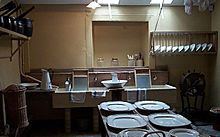|
Scullery A scullery is a room in a house, traditionally used for washing up dishes and laundering clothes, or as an overflow kitchen. Tasks performed in the scullery include cleaning dishes and cooking utensils (or storing them), occasional kitchen work, ironing, boiling water for cooking or bathing, and soaking and washing clothes. Sculleries contain hot and cold sinks, sometimes slop sinks, drain pipes, storage shelves, plate racks, a work table, various coppers for boiling water, tubs, and buckets.[1] The term "scullery" has fallen into disuse in North America, as laundry takes place in a utility room[2] or laundry room. The term continues in use in its original sense in Britain and Ireland amongst the middle classes, or as an alternative term for kitchen in some regions of Britain, typically Northern Ireland and Scotland, or in designer kitchens.[3] In United States military facilities and most commercial restaurants, a "scullery" refers to the section of a dining facility[4] where pots and pans are scrubbed and rinsed (in an assembly line style). It is usually near the kitchen and the serving line.[5] EtymologyAccording to the Merriam-Webster Online Dictionary: Middle English squilerie, sculerie, department of household in charge of dishes, from Anglo-French esquilerie, from escuele, eskel bowl, from Latin scutella, drinking bowl.[6] The traditional household sculleryThe scullery was a back kitchen located adjacent to the main kitchen, frequently to the rear of the house[7] nearest the water supply, such as a public fountain or a well, or near a barrel that collected rain water, which was the preferred water for washing dishes.[8] In houses built prior to indoor plumbing, scullery sinks were located against an outside wall.[9] Since sculleries were used for washing and great quantities of water had to be carried inside, they were made with solid floors of brick, stone, terracotta tiles,[10] or concrete. Although a drain, known as a soil pipe, would carry the dirty water outside of the house, the floors were likely to stay wet. The scullery maid, or person washing dishes at the sink, would stand on slatted wood mats near the sinks. The floor itself was often dug six inches or so (150mm) below the main house floor in case of leaks or flooding.[11] In designing a scullery, architects would take care to place the room adjacent to the kitchen with a door leading directly outside to conveniently obtain water. However, for sanitation purposes (since so much slop was processed in the scullery) no doors led from there to the pantry or store rooms.[12] Scullery sinks came in pairs, one for hot water and the other for cold water. They were square or rectangular in shape, shallow, and made of non-absorbent materials, such as the slate sinks at Chawton House [13] or lined with copper to protect delicate dishes. Per the 1891 instruction manual, Principles and Practice of Plumbing:
In addition to washing dishes and preparing foods for roasting and boiling, such as cleaning vegetables and dressing poultry, game, and fish,[15] the scullery was used for boiling water and doing laundry, which necessitated the following equipment:
Sanitation was a special concern for house owners, whose sculleries could be the source of illness if they were not properly drained or kept clean. Grease, which abounded in scullery sink water, could choke up a soil pipe and start stinking up the house (see fatberg). Water from green vegetables also has a peculiarly objectionable smell, thus drainage was of the utmost importance. "The most generally recommended arrangement for carrying away scullery sink water is to make the pipe pass through the scullery wall terminating a little above the ground and to discharge its contents into an open drain from which it is conducted by a pipe into the drain leading to the sewer."[17] In the late 19th century, unsanitary conditions in sculleries and privies could lead to frequent bouts of infectious illness among the home's occupants. A writer in an 1898 edition of the medical journal The Lancet,[18] observed:
Hospital sculleriesFor maximum sanitation, the 19th century English nurse, Florence Nightingale, recommended that porcelain sinks should be used in sculleries attached to hospital wards. "The best sink for a scullery is the new white porcelain sink recently introduced with hot and cold water laid on. Care must be taken that the waste pipe has no direct communication with a closed drain otherwise foul air is certain to find its way into the hospital."[19] References
External linksWikimedia Commons has media related to Sculleries. Look up scullery in Wiktionary, the free dictionary. |